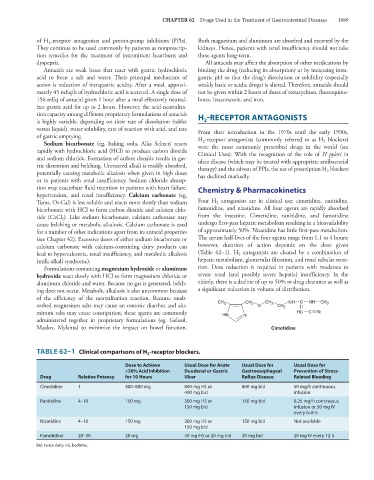Page 1103 - Basic _ Clinical Pharmacology ( PDFDrive )
P. 1103
CHAPTER 62 Drugs Used in the Treatment of Gastrointestinal Diseases 1089
of H receptor antagonists and proton-pump inhibitors (PPIs). Both magnesium and aluminum are absorbed and excreted by the
2–
They continue to be used commonly by patients as nonprescrip- kidneys. Hence, patients with renal insufficiency should not take
tion remedies for the treatment of intermittent heartburn and these agents long-term.
dyspepsia. All antacids may affect the absorption of other medications by
Antacids are weak bases that react with gastric hydrochloric binding the drug (reducing its absorption) or by increasing intra-
acid to form a salt and water. Their principal mechanism of gastric pH so that the drug’s dissolution or solubility (especially
action is reduction of intragastric acidity. After a meal, approxi- weakly basic or acidic drugs) is altered. Therefore, antacids should
mately 45 mEq/h of hydrochloric acid is secreted. A single dose of not be given within 2 hours of doses of tetracyclines, fluoroquino-
156 mEq of antacid given 1 hour after a meal effectively neutral- lones, itraconazole, and iron.
izes gastric acid for up to 2 hours. However, the acid-neutraliza-
tion capacity among different proprietary formulations of antacids H -RECEPTOR ANTAGONISTS
is highly variable, depending on their rate of dissolution (tablet 2
versus liquid), water solubility, rate of reaction with acid, and rate From their introduction in the 1970s until the early 1990s,
of gastric emptying. H -receptor antagonists (commonly referred to as H blockers)
Sodium bicarbonate (eg, baking soda, Alka Seltzer) reacts 2 2
rapidly with hydrochloric acid (HCl) to produce carbon dioxide were the most commonly prescribed drugs in the world (see
Clinical Uses). With the recognition of the role of H pylori in
and sodium chloride. Formation of carbon dioxide results in gas- ulcer disease (which may be treated with appropriate antibacterial
tric distention and belching. Unreacted alkali is readily absorbed, therapy) and the advent of PPIs, the use of prescription H blockers
potentially causing metabolic alkalosis when given in high doses has declined markedly. 2
or to patients with renal insufficiency. Sodium chloride absorp-
tion may exacerbate fluid retention in patients with heart failure, Chemistry & Pharmacokinetics
hypertension, and renal insufficiency. Calcium carbonate (eg,
Tums, Os-Cal) is less soluble and reacts more slowly than sodium Four H antagonists are in clinical use: cimetidine, ranitidine,
2
bicarbonate with HCl to form carbon dioxide and calcium chlo- famotidine, and nizatidine. All four agents are rapidly absorbed
ride (CaCl ). Like sodium bicarbonate, calcium carbonate may from the intestine. Cimetidine, ranitidine, and famotidine
2
cause belching or metabolic alkalosis. Calcium carbonate is used undergo first-pass hepatic metabolism resulting in a bioavailability
for a number of other indications apart from its antacid properties of approximately 50%. Nizatidine has little first-pass metabolism.
(see Chapter 42). Excessive doses of either sodium bicarbonate or The serum half-lives of the four agents range from 1.1 to 4 hours;
calcium carbonate with calcium-containing dairy products can however, duration of action depends on the dose given
lead to hypercalcemia, renal insufficiency, and metabolic alkalosis (Table 62–1). H antagonists are cleared by a combination of
2
(milk-alkali syndrome). hepatic metabolism, glomerular filtration, and renal tubular secre-
Formulations containing magnesium hydroxide or aluminum tion. Dose reduction is required in patients with moderate to
hydroxide react slowly with HCl to form magnesium chloride or severe renal (and possibly severe hepatic) insufficiency. In the
aluminum chloride and water. Because no gas is generated, belch- elderly, there is a decline of up to 50% in drug clearance as well as
ing does not occur. Metabolic alkalosis is also uncommon because a significant reduction in volume of distribution.
of the efficiency of the neutralization reaction. Because unab-
sorbed magnesium salts may cause an osmotic diarrhea and alu- CH 3 CH 2 S CH 2 CH 2 NH C NH CH 3
minum salts may cause constipation, these agents are commonly HN N HC C N
administered together in proprietary formulations (eg, Gelusil,
Maalox, Mylanta) to minimize the impact on bowel function. Cimetidine
TABLE 62–1 Clinical comparisons of H -receptor blockers.
2
Dose to Achieve Usual Dose for Acute Usual Dose for Usual Dose for
>50% Acid Inhibition Duodenal or Gastric Gastroesophageal Prevention of Stress-
Drug Relative Potency for 10 Hours Ulcer Reflux Disease Related Bleeding
Cimetidine 1 400–800 mg 800 mg HS or 800 mg bid 50 mg/h continuous
400 mg bid infusion
Ranitidine 4–10 150 mg 300 mg HS or 150 mg bid 6.25 mg/h continuous
150 mg bid infusion or 50 mg IV
every 6–8 h
Nizatidine 4–10 150 mg 300 mg HS or 150 mg bid Not available
150 mg bid
Famotidine 20–50 20 mg 40 mg HS or 20 mg bid 20 mg bid 20 mg IV every 12 h
bid, twice daily; HS, bedtime.

